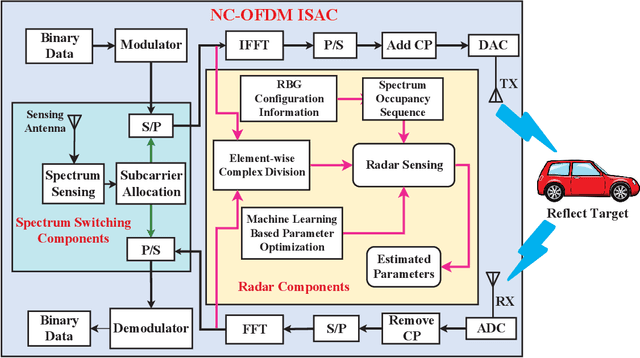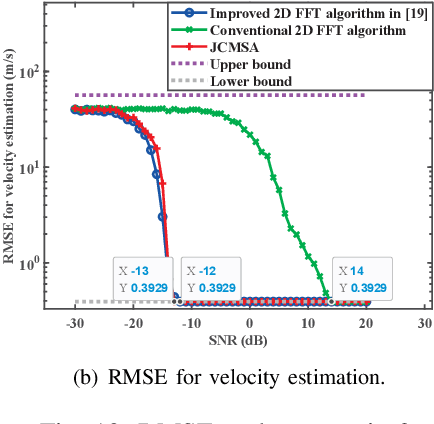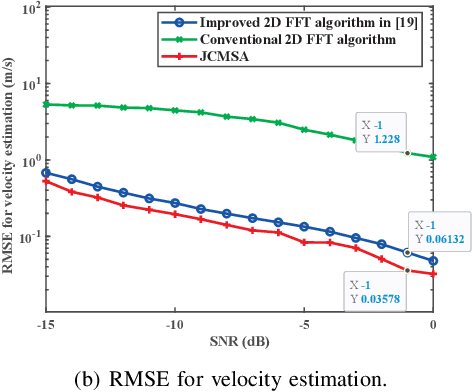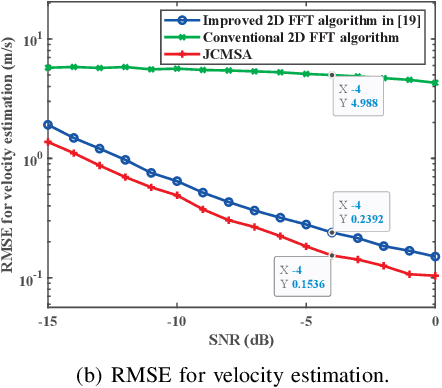Hanyang Qu
ISAC Signal Processing Over Unlicensed Spectrum Bands
Oct 04, 2023



Abstract:As a promising key technology of 6th-Generation (6G) mobile communication systems, integrated sensing and communication (ISAC) technology aims to make full use of spectrum resources to enable the functional integration of communication and sensing. The ISAC-enabled mobile communication systems regularly operate in non-continuous spectrum bands due to crowded licensed frequency bands. However, the conventional sensing algorithms over non-continuous spectrum bands have disadvantages such as reduced peak-to-sidelobe ratio (PSR) and degraded anti-noise performance. Facing this challenge, we propose a high-precision ISAC signal processing algorithm based on compressed sensing (CS) in this paper. By integrating the resource block group (RBG) configuration information in 5th-Generation new radio (5G NR) and channel information matrices, we can dynamically and accurately obtain power estimation spectra. Moreover, we employ the fast iterative shrinkage-thresholding algorithm (FISTA) to address the reconstruction problem and utilize K-fold cross validation (KCV) to obtain optimal parameters. Simulation results show that the proposed algorithm has lower sidelobes or even zero sidelobes and high anti-noise performance compared with conventional sensing algorithms.
Iterative Signal Processing for Integrated Sensing and Communication Systems
Jun 08, 2023Abstract:Integrated sensing and communication (ISAC), with sensing and communication sharing the same wireless resources and hardware, has the advantages of high spectrum efficiency and low hardware cost, which is regarded as one of the key technologies of the fifth generation advanced (5G-A) and sixth generation (6G) mobile communication systems. ISAC has the potential to be applied in the intelligent applications requiring both communication and high accurate sensing capabilities. The fundamental challenges of ISAC system are the ISAC signal design and ISAC signal processing. However, the existing ISAC signal has low anti-noise capability. And the existing ISAC signal processing algorithms have the disadvantages of quantization errors and high complexity, resulting in large energy consumption. In this paper, phase coding is applied in ISAC signal design to improve the anti-noise performance of ISAC signal. Then, the effect of phase coding method on improving the sensing accuracy is analyzed. In order to improve the sensing accuracy with low-complexity algorithm, the iterative ISAC signal processing methods are proposed. The proposed methods improve the sensing accuracy with low computational complexity, realizing energy efficient ISAC signal processing. Taking the scenarios of short distance and long distance sensing into account, the iterative two-dimensional (2D) fast Fourier transform (FFT) and iterative cyclic cross-correlation (CC) methods are proposed, respectively, realizing high sensing accuracy and low computational complexity. Finally, the feasibility of the proposed ISAC signal processing methods are verified by simulation results.
Integrated Sensing and Communication Signals Towards 5G-A and 6G: A Survey
Jan 10, 2023



Abstract:Integrated sensing and communication (ISAC) has the advantages of efficient spectrum utilization and low hardware cost. It is promising to be implemented in the fifth-generation-advanced (5G-A) and sixth-generation (6G) mobile communication systems, having the potential to be applied in intelligent applications requiring both communication and high-accurate sensing capabilities. As the fundamental technology of ISAC, ISAC signal directly impacts the performance of sensing and communication. This article systematically reviews the literature on ISAC signals from the perspective of mobile communication systems, including ISAC signal design, ISAC signal processing algorithms and ISAC signal optimization. We first review the ISAC signal design based on 5G, 5G-A and 6G mobile communication systems. Then, radar signal processing methods are reviewed for ISAC signals, mainly including the channel information matrix method, spectrum lines estimator method and super resolution method. In terms of signal optimization, we summarize peak-to-average power ratio (PAPR) optimization, interference management, and adaptive signal optimization for ISAC signals. This article may provide the guidelines for the research of ISAC signals in 5G-A and 6G mobile communication systems.
 Add to Chrome
Add to Chrome Add to Firefox
Add to Firefox Add to Edge
Add to Edge